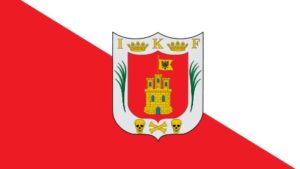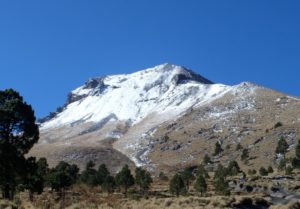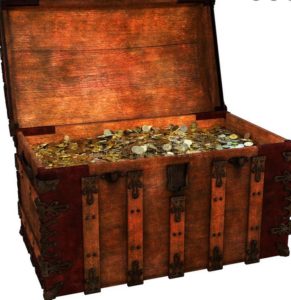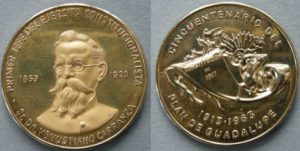Podcast: Play in new window | Download
Subscribe: Apple Podcasts | RSS
 Located in the heart of Mexico, Tlaxcala is the country’s smallest state, making up only two tenths of a percent of Mexico’s total land area. The origin of the name of the state and its capital city comes from the language Nahuatl, and may derive from the word texcalli, meaning “rocky outcrop,” or the word tlaxcallan, meaning “place of corn tortillas.” The old Aztec name glyph for Tlaxcala included both these elements, showing a hand making tortillas between two mountains. The ancient Tlaxcalan state was never incorporated into the Aztec Empire which surrounded it. The rulers of the Aztecs used battles with the Tlaxcalans as practice for their warriors but never sought to conquer their lands. When the Spanish came, the Tlaxcalans allied with the European invaders to defeat the Aztecs and were thus granted special privileges during colonial times, including keeping their homeland intact. After Mexican independence Tlaxcala became a federal territory and then a state in 1857. This small Mexican state has a rich history and is thus home to many legends, some dating back well over a thousand years. Here are three.
Located in the heart of Mexico, Tlaxcala is the country’s smallest state, making up only two tenths of a percent of Mexico’s total land area. The origin of the name of the state and its capital city comes from the language Nahuatl, and may derive from the word texcalli, meaning “rocky outcrop,” or the word tlaxcallan, meaning “place of corn tortillas.” The old Aztec name glyph for Tlaxcala included both these elements, showing a hand making tortillas between two mountains. The ancient Tlaxcalan state was never incorporated into the Aztec Empire which surrounded it. The rulers of the Aztecs used battles with the Tlaxcalans as practice for their warriors but never sought to conquer their lands. When the Spanish came, the Tlaxcalans allied with the European invaders to defeat the Aztecs and were thus granted special privileges during colonial times, including keeping their homeland intact. After Mexican independence Tlaxcala became a federal territory and then a state in 1857. This small Mexican state has a rich history and is thus home to many legends, some dating back well over a thousand years. Here are three.
- Matlalcueitl and the Legend of the Three Mountains
Long before the Nahua-speaking Tlaxcalans settled in the territory that would later become Tlaxcala, the area was ruled by a people called the Olmecs-Xicalancas. Archaeologists believe that these people originally came from the Gulf Coast and the art and architecture they left behind exhibit a distinctly Maya flavor. During the Olmeca-Xicalanca times there was a king ruling one of the valleys of Tlaxcala called Colopechtli who was regarded as mean and decadent. In Colopechtli’s small kingdom there was a village at the edge of a massive forest in which a beautiful young woman lived who attracted much attention. She wore luxurious clothes embroidered with quetzal feathers and rabbit hair. She wore dazzling handcrafted ornaments which made her stand out even more. Anyone seeing her would think she was a princess. Her name was Matlalcueitl.
On one occasion the beautiful young woman attended one of the great ritual festivals in the capital city of Cacaxtla. A handsome warrior captain named Tentzo from the Tepeyacac region admired her and fell in love with her. Through mutual acquaintances Tentzo eventually met Matlalcueitl and began to court her. This small-town girl had an almost hypnotic effect on the handsome warrior. Matlalcueitl’s family approved of the relationship because it improved their social status. If the two eventually married it would mean better times for Matlalcueitl’s family who for generations lived in that same village eking out a meager existence.
While the young warrior Tentzo was fulfilling his military obligations, Matlalcueitl went to another major festival in Cacaxtla. One of the important foreign dignitaries at that festival was the king of the Totonacs named Pinahutzatzin who had traveled may days with his entourage to visit Cacaxtla. As soon as the Totonac king saw the beautiful Matlalcueitl he fell in love with the girl. The Totonac king was considered a more highly prized suitor than the Tepeyacan captain. Metlalcueitl returned the foreign king’s favors and decided to leave Tlaxcala to become the new queen  consort of the Totonacs. On the night before Matlalcueitl was to leave for the Totonac kingdom, the warrior Tentzo confronted her. They argued, and angered by his beloved’s betrayal, the warrior plunged an obsidian dagger into the chest of the beautiful young girl. Tentzo placed Matlalcueitl’s body on a teocalli, the temple on the flat top of a low pyramid. He left her there and overnight she turned into a mountain known today by locals as Malintzi.
consort of the Totonacs. On the night before Matlalcueitl was to leave for the Totonac kingdom, the warrior Tentzo confronted her. They argued, and angered by his beloved’s betrayal, the warrior plunged an obsidian dagger into the chest of the beautiful young girl. Tentzo placed Matlalcueitl’s body on a teocalli, the temple on the flat top of a low pyramid. He left her there and overnight she turned into a mountain known today by locals as Malintzi.
The story does not end here. Upon hearing of the death of his future queen, the king of the Totonacs hunted down the warrior Tentzo. Tentzo was eventually apprehended by the king’s men. They brought him to King Pinahutzatzin to engage in a fight to the death. Both men were highly skilled in combat, so it was a fair fight. The Totonac king wielded his macuahuitl, which was an ancient Mexican wooden club studded with obsidian blades, and with one blow cut off the head of the young warrior Tentzo. The detached head became a hill next to Malintzi now known as Cuatlapanga, which in Nahuatl literally means “severed head.” After the duel, King Pinahutzatzin tried to get back to the Totonac kingdom, but a lynch mob prevented him from leaving Tlaxcala territory. The mob eventually attacked and killed the king and his body transformed into a small mountain called Cofre de Perote, which is also known by the name of Pinahutzatzin.
- The Huarache Maker and the Devil
Legend has it that in the middle of the 1800s a humble maker of huaraches named Ramón lived with his wife in a poor hut located on Calle Iturbide, now known as Calle de Reforma Norte in the city of Huamantla in the eastern part of the state of Tlaxcala. Because of the extreme poverty in which they lived, the desperate woman constantly complained to her husband, saying things like: “If our misery continues, we are going to starve!” The poor huarache maker, felt a great sense of despair when listening to these continual reproaches, and then he would blaspheme furiously: “Damn luck! I rip my skin working day and night and I can’t get ahead; I swear to you that if the devil gave me money, I would sell my soul to the devil himself.”
People said that Ramón began to go out at night to unknown places where it was claimed that he spoke directly with Satan. Days later he rode a good horse on which he made his night journeys and returned once with bags full of money. From those days on, the life of that couple changed remarkably. Reproaches stopped on the part of the woman and despair ended on the part of the man. They dressed and ate better, the man worked less and got more drunk. However, all good things must come to an end. One day Ramón fell into bed ill, and soon died. His wife bought him an elegant coffin and ordered a good meal to be made to entertain the companions who would stand alongside the grieving widow at the funeral.
 The funeral procession left in the direction of the Church of the Dulce Nombre in whose cemetery the huarache maker would be buried. When they entered the small square in front of this church, suddenly everyone heard from a distance a thunderous noise produced by a whirlwind that snapped tree branches and caused roof tiles of some houses to fly into the air. Moments later that intense whirlwind crossed the path of the funeral procession. The strong impact of the wind caused the pallbearers to stagger in confusion, and the mourners ceased their funeral chants. Many closed their eyes to protect themselves from the effects of the dust and the harsh wind, but when looking towards the course that that whirlwind was taking, they could notice in the heights a strange silhouette that resembled the figure of a human being. Many thought that this was clothing that had been torn from some clothesline. After having recovered a little from the chilling impact of the wind that filled them with terror, the pallbearers had the need to rest the coffin in that square. They all noticed something strange: the weight of the coffin had decreased considerably.
The funeral procession left in the direction of the Church of the Dulce Nombre in whose cemetery the huarache maker would be buried. When they entered the small square in front of this church, suddenly everyone heard from a distance a thunderous noise produced by a whirlwind that snapped tree branches and caused roof tiles of some houses to fly into the air. Moments later that intense whirlwind crossed the path of the funeral procession. The strong impact of the wind caused the pallbearers to stagger in confusion, and the mourners ceased their funeral chants. Many closed their eyes to protect themselves from the effects of the dust and the harsh wind, but when looking towards the course that that whirlwind was taking, they could notice in the heights a strange silhouette that resembled the figure of a human being. Many thought that this was clothing that had been torn from some clothesline. After having recovered a little from the chilling impact of the wind that filled them with terror, the pallbearers had the need to rest the coffin in that square. They all noticed something strange: the weight of the coffin had decreased considerably.
The widow and some relatives of the deceased proceeded to open that coffin to say goodbye to their loved one, but to the astonishment of all those present, the corpse had disappeared. The only thing inside that coffin was a bag filled with gold coins, from which a disgusting aroma came out. Although they were in the presence of much wealth, all the mourners ran away, knowing that the devil would soon appear, coming to the town to reclaim his loot.
- The Lost Treasure of Venustiano Carranza
The City of Tetla, Tlaxcala, has had an interesting rumor dating back almost 100 years, related to the times immediately after the Mexican Revolution. In 1920 when Mexican president Venustiano Carranza left office, stories spread that – like so many Mexican presidents before and since – Carranza stole money from the Mexican treasury. Crates full of gold bars and gold and silver coins supposedly left Mexico City by train the night Carranza was forced to leave the capital. Upon reaching the town of Apizaco the train rumored to be full of treasure had to stop. At this time the locals looted the train, carrying off dozens of heavy wooden boxes which they hid in the houses of Tetla, or buried in their fields. Venustiano Carranza’s men found out about what happened, but the people of Tetla would not admit to any wrongdoing and the boxes of treasure were never found. One of Carranza’s men put a curse on anyone who spent or found the treasure. Since they could not recover the gold and silver, and men from the new administration were hot on their tails, that was the most they could do.
Many years later a shepherd was walking through a field outside of Tetla when he lost a calf. In his search he found a box full of coins. Happy with the discovery, he put all the coins he could into his pockets, but he couldn’t carry everything. He went to town and told his neighbors that he found a box full of coins. Everyone left feeling very enthusiastic. When they got to the designated place they saw the box, but nothing of the treasure. Instead of coins the box was full of ash. The neighbors, who had already spent the money in their heads, became monumentally angry, beating the poor shepherd until he was dead.
 Time passed, and people forgot the incident. In the 1930s, two young people, boyfriend and girlfriend, were walking near a ravine when they accidentally stumbled upon a box that was opened displaying hundreds of dazzling coins. The happy couple took part of the treasure and upon returning to their homes, they told their families about their discovery. They all went together to the place where they had found the box. But history repeated itself. The box was full of ashes and there was no treasure. The girl’s father then went into a tirade, directing all his anger at the young man who supposedly discovered the treasure with his girl. Then, the boy’s father defended his son violently. The two fathers both killed each other.
Time passed, and people forgot the incident. In the 1930s, two young people, boyfriend and girlfriend, were walking near a ravine when they accidentally stumbled upon a box that was opened displaying hundreds of dazzling coins. The happy couple took part of the treasure and upon returning to their homes, they told their families about their discovery. They all went together to the place where they had found the box. But history repeated itself. The box was full of ashes and there was no treasure. The girl’s father then went into a tirade, directing all his anger at the young man who supposedly discovered the treasure with his girl. Then, the boy’s father defended his son violently. The two fathers both killed each other.
As time went by, other stories emerged of some people who had suddenly been seen with many riches. Such is the case of Susana. It is said that she found part of the treasure and that with it she dedicated herself to living a life of luxury. When asked, she said that the money belonged to her husband who sent it to her from working abroad, but one day the husband showed up and he didn’t seem exactly rich. The man saw how his wife lived, and also that she was now keeping the company of a much younger man. Susana told her husband to forget about her, so the husband, blinded by grief, killed Susana’s lover. She fled leaving her wealth behind, yet another victim of the curse of Carranza’s treasure.
REFERENCES
Para Todo Mexico website (in Spanish)
Tlaxcala Tourism board website (in Spanish)
